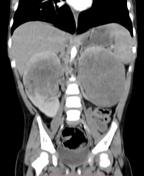Presentation
Ill looking child with abdominal pain and swelling.
Patient Data
Age: 2 years
Gender: Female
From the case:
Nephroblastoma - bilateral




Download
Info

Right kidney: A large, lobulated, predominantly solid mass lesion with hypodense non-enhancing necrotic areas is seen arising from the inter-polar region of the right kidney.
Left kidney: A large, lobulated, predominantly solid mass lesion with hypodense non-enhancing necrotic areas is also arising from the inter-polar region of the left kidney replacing majority of the left kidney.
Case Discussion
Less than five percent of nephroblastoma cases occur bilaterally.




 Unable to process the form. Check for errors and try again.
Unable to process the form. Check for errors and try again.